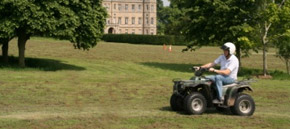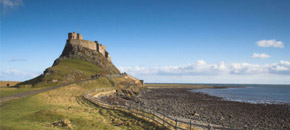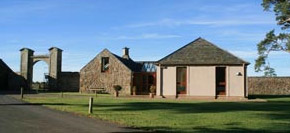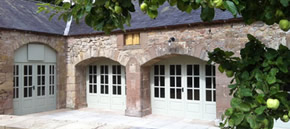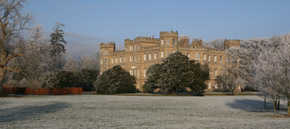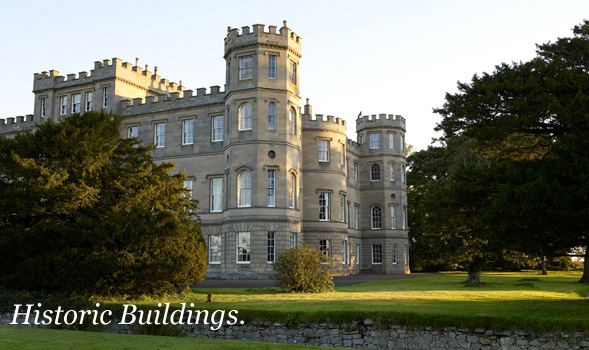
Berwickshire is a famously unspoilt landscape packed with historically interesting places, many of them with connections to Wedderburn. Within 21 miles of the castle you will find all of the suggested attractions and activities listed here:
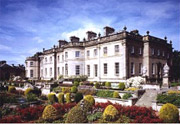
Manderston House.
The neighbouring estate to Wedderburn and home of the Lord Palmer. Manderston was the last great country house to be constructed in Britain. Built for the construction magnate Sit James Miller on an apparently unlimited budget, Manderston has the only solid sterling silver staircase in the world. Open from mid-May to the end of September on Thursdays and Sundays 1.30pm until 5pm. We will be pleased to arrange out of season group visits. NT810543 www.manderston.co.uk
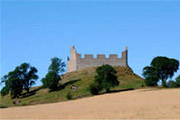
Hume Castle.
The original power base of the clan, Hume Castle has the finest view in the Borders and is a rare example of the remains of a 13th century castle. It really doesn't matter that the walls you see today are a folly constructed in 1794 for the last Earl of Marchmont (another cousin whose portrait hangs in the drawing room at Wedderburn) the site is awe-inspiring. Accessible all year, free NT704414
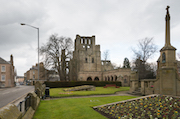
Kelso Abbey.
Started in 1128 and completed in 1243, this is perhaps the finest example of Romanesque architecture in Britain. While in Kelso, it is worth taking time to enjoy the town square- in my opinion one of the most pleasant in Scotland. Accessible all year, free NT728339 Image by kind permission of Historic Environment Scotland

Floors Castle.
A 10 minute walk from the Kelso town square lays the seat of the 10th Duke of Roxburghe. The largest house in Scotland (I should think) almost defies belief. Started in 1721 to a design by William Adam (the father of Robert and James Adam who designed Wedderburn Castle) and later remodeled by William Playfair. Brilliant right from the front gates to the ironing boards. Opening times 1st May to 31st October, out of season group visits by arrangement. NT711346
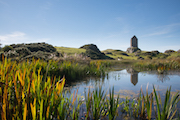
Smailholm Tower.
A stark and well preserved 15th century tower house, said to have inspired Sir Walter Scott who lived nearby as a boy. On the way to Smailholm you will drive through the village of Gordon heading West. At the bottom of the hill glance right and you will see Greenknowe Tower, a beautiful ruined tower house originally constructed as a hunting lodge, now in the care of Historic Scotland. Open from 21st March to 30th September, and weekends all year 9.30am to 4pm. NT639346 Image courtesy of Historic Environment Scotland
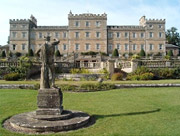
Mellerstain House.
While in the vicinity of Smailholm and Greenknowe (NT641429) take the opportunity to visit the house and grounds of Mellerstain. Highly reminiscent of Wedderburn itself, but on a larger scale, it is perhaps not surprising to discover that Mellerstain was designed by Robert and James Adam's father William Adam and although started in 1725 was not completed until 1778, three years later than Wedderburn. Robert Adam's fine interiors at Mellerstain are of particular interest and are indicative of what a completed interior scheme at Wedderburn might have looked like. Opening times variable- check web site, Out of season group visits by arrangement. NT647390
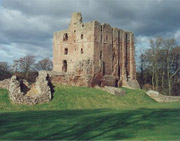
Norham Castle.
While at Wedderburn it is worth remembering that we are close to the border with England. If you have made the effort to travel from England to visit Scotland, don't ignore Northumberland! Norham Castle stands on the river Tweed, at the border, and is reckoned by English Heritage to be 'one of the most impressive medieval fortresses in northern England'. I agree. Open from 21st March – 30th September (English Heritage) NT906476
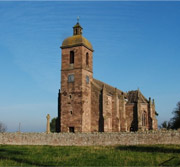
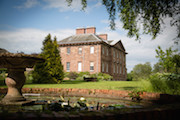
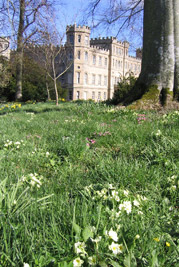
Ladykirk Church.
It is recorded that one day In August 1497 King James IV sat by the South bank of the Tweed playing cards with the Spanish Ambassador while returning from a raid into England. King James found just above Norham (where they had blasted the castle using Mons Meg, a mighty cannon now at Edinburgh Castle) that the river Tweed had risen at the ford and made a vow that, if he and his men got safely over, on the high bank on the north side he would build a Kirk to Our Lady that 'fire would not burn nor water destroy'. Upsettlington was thus re-named Ladykirk, and the church was constructed entirely of stone- even the roof is solid stone and it would indeed be difficult to burn down or wash away. The Church may be locked, but can be visited at any time. NT889475
Paxton House.
An important 18th century Palladian country house built for Patrick Home in 1758 (who also built Wedderburn around his ancestral castle in 1771) on the banks of the river Tweed.
Designed by John Adam, interiors by Robert Adam. Paxton contains a fine collection of furniture by Chippendale and Trotter, some of which you will also enjoy the use of while in residence at Wedderburn. The picture gallery displays a permanent exhibition of 70 paintings from the National Galleries of Scotland.
The grounds are well worth exploring and include an adventure playground for children. Following the banks of the River Tweed you may see otters and the Union Chain Bridge, which is the oldest road suspension bridge in the world, constructed by a friend of the family in 1820.
Paxton's a fine snug place, Robin Adair,
It's a wondrous couthie place, Robin Adair;
Let Whitadder rin a spate
Or the wind blow at ony rate,
Yet I'll meet thee on the gait, Robin Adair.
The Paxton estate belonged to the Paxtons of that Ilk who were among the unfortunate Borderers who in early times held land in both kingdoms and experienced the inevitable difficulty of serving two masters. The Paxtons were forfeited both by English and Scottish Kings. Paxton was burnt by the Duke of Gloucester in 1482 and by the Duke of Norfolk, who laid the neighbourhood waste in 1540. At the Union the Paxtons only had a few acres left. Sir Joseph Paxton, who built the Crystal Palace, came of that stock. The estate was purchased by Rev.Ninian Home who subsequently passed it to his son Patrick who built the house we see today.
Open from Good Friday to 31st October. We will be pleased to arrange out of season group visits. www.paxtonhouse.co.uk NT932519 Image courtesy of the Trustees of Paxton House
Wedderburn Castle.
Since you are here, this is a brief history of the family and of the castle. Wedderburn is assumed to take its name from Clan Wedderburn. The first person by the name of Wedderburn to appear on record in Scotland is Walter de Wedderburn, who appears on the Ragman Rolls in 1296.
The lands of Clan Wedderburn passed in 1413 to Sir David Home. At this time the castle was a simple tower around which the structure you see today was built. A white stone plaque from this date can be seen in the present courtyard and it is thought that the haha (ditch with concealed wall to stop cattle and sheep) surrounding the castle may follow the line of the original castle palisade.
The family had the tragic distinction of seeing every first son die either in battle or as a prisoner of the English from 1413 to 1576, a time when life in the border country was often short and brutal. Sir David's grandson, of the same name, and the eldest of his seven sons, Sir George both died at the battle of Flodden Field in 1513 and may be buried in the burial ground here. Walter Scott famously tells the tale of the 'Seven spears of Wedderburn' in the Lay of Last Minstrel. Sir David married Isabella Hoppringle of Smailholm in 1481, providing a family link to one of the most enigmatic Border towers. Isabella died at Wedderburn in 1545.
The union of the Scottish and English crowns under James VI (portrait on right of fire place in morning room) in 1603 began the long path to the formal Act of Union in 1707. This brought an unfamiliar calm to the border country. Landed families could concentrate their revenues on building grand houses without concern for fortification and engage in the rapid intellectual and philosophical (and recreational) developments now known as the Scottish Enlightenment.
David Hume (1711-1776) of Ninewells, a farm four miles East of Wedderburn is one of the leading figures of the Scottish Enlightenment. David Hume is of the same clan as the Homes of Wedderburn, but is not a close cousin.
Sir George Home (1667 to 1720) 10th Baron of Wedderburn fought for the Jacobite cause at the battle of Preston in 1715 where he was captured, tried for treason and his estates forfeited. Luckily for him he was pardoned and since his estates were already mortgaged to his enterprising cousin Rev. Ninian Home of Billie (1670 to 1744) it was decreed that the crown could not take possession.
The present building of Wedderburn Castle was started in 1771 by Ninian's son Patrick Home (1728 to 1808, 13th Baron of Wedderburn), who left his nephew George to oversee the building works. Robert and James Adam were commissioned as architects and Wedderburn is recognised today as one of their earliest and most perfect castle designs.
During construction Patrick himself undertook a grand tour of the continent, from where he sent back a large number of works of art including the outstanding chimney-pieces seen today. The only significant alterations made since that time are the addition of the port cochere and the creation of the two storey stair hall, probably to a design by James Gillespie-Graham in 1820. The old castle was pulled down to create the courtyard. The stair and the balustrade are identical in some respects to those found at Paxton House and at Milne Graden, the house of Admiral Sir David Milne (1763 to 1845), a very great friend of George Home and also a distant cousin. On George Home's death the estates of Wedderburn, Paxton and Billie passed to his aunt Jean, and subsequently through a female line to the present day.
Wedderburn is an exclusive-use venue for weddings, special occasions and corporate events. Enquire here. NT808528
Please note
For all expeditions by road or on foot we recommend that you use Ordnance Survey maps that are available to purchase online. Each location here is shown with a grid reference. Post codes are sometimes not useful in very rural areas! Type the number (for example NT 808 528) into the search box at:
Ordnance Survey Get-a-map
Wedderburn Castle, Duns, Berwickshire, TD11 3LT, Scotland, UK.

